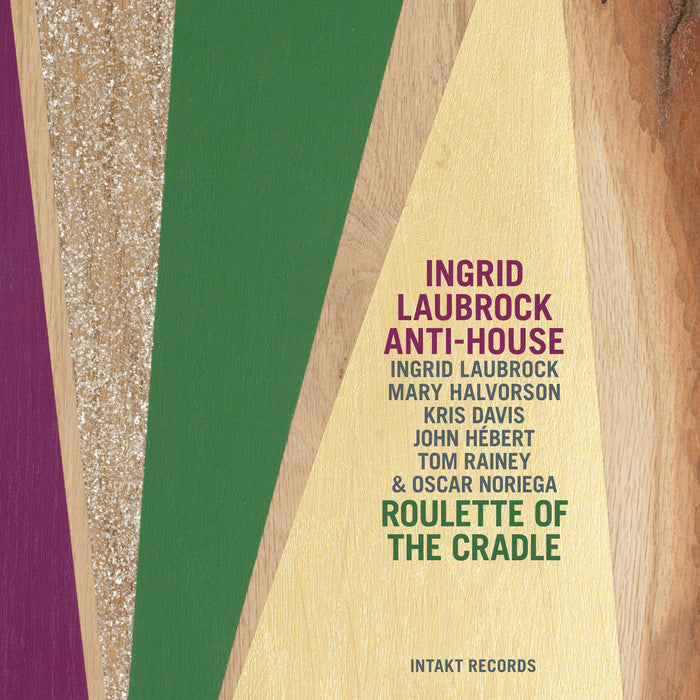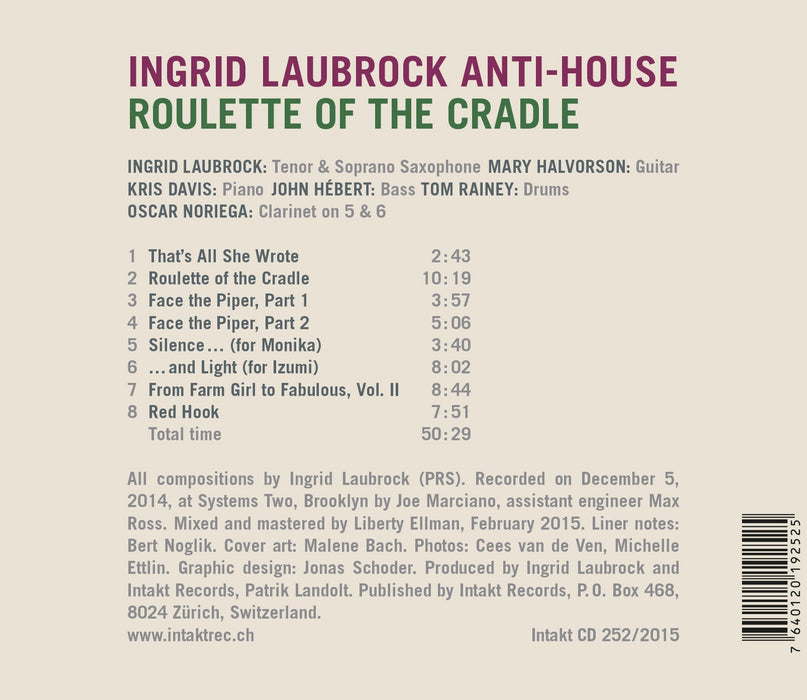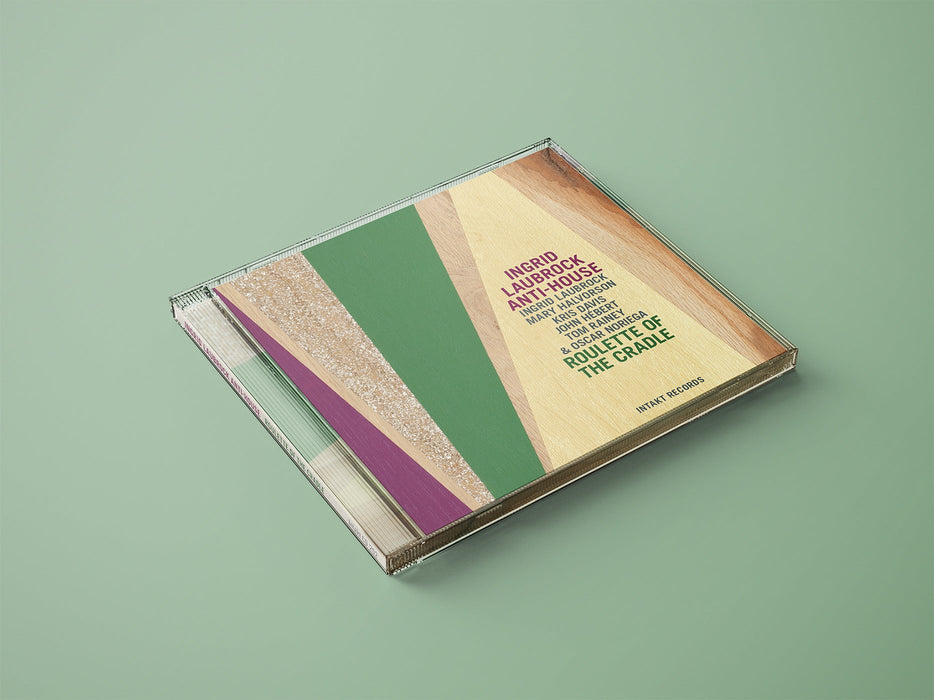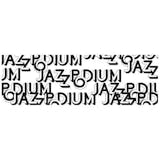


252: INGRID LAUBROCK – ANTI-HOUSE. Roulette Of The Cradle
Intakt Recording #252/ 2015
Ingrid Laubrock: Saxophones
Mary Halvorson: Guitar
Kris Davis: Piano
John Hébert: Bass
Tom Rainey: Drums
Guest: Oscar Noriega: Clarinet
Recorded on December 5, 2014 at Systems Two, Brooklyn, New York.
More Info
Anti-House is perhaps Laubrock’s most New York-centric band, comprised of herself on tenor and soprano Saxophones, guitarist Mary Halvorson, pianist Kris Davis, bassist John Hébert, and drummer Tom Rainey. Bert Noglik writes in the liner notes of this third release «Roulette of the Cradle»: «Abstraction and reification, accentuation and accumulation, laid-back and pushing. The music of this quintet thrives on strong contrasts and the tension they create. The dynamic spectrum is almost taken to its limits, a lot of things are happening simultaneously.
Ingrid Laubrock calls the shots, always with an ear to the particular expressive potential and sounds of the individual musicians. Through her growing experience as a player this happens with increasing aplomb, which also accounts for the forward leap when compared to the previous recordings with the band – Anti-House (2010) and AntiHouse: Strong Place (2012).
There is as much a desire for form as for opening up the playing process towards the unpredictable, the unexpected. It is especially the high quality of the musicians contributing to the unmistakable group sound of Anti-House and, at the same time, the powerful individual styles that don’t just meld together but potentiate each other, as well.»
Album Credits
Cover art: Malene Bach
Graphic design: Jonas Schoder
Photos: Cees van de Ven
Liner notes: Bert Noglik
All compositions by Ingrid Laubrock (PRS). Recorded on December 5,
2014 at Systems Two, Brooklyn by Joe Marciano, assistant engineer
Max Ross. Mixed and mastered by Liberty Ellman, February 2015.
Ingrid Laubrock er en svært så spennende saksofonist, komponist og bandleder som også har tatt New York med storm. Ikke nok med det: i bandet sitt har hun også med seg to andre ledende kvinnelige instrumentalister.
Ingrid Laubrock, nummer to fra høyre, med sitt Anti-House.
Tenor- og sopransaksofonisten Ingrid Laubrock (47), som opprinnelig kommer fra en liten by i Tyskland, har hatt en bemerkelsesverdig rute frem til en viktig posisjon i toppen av moderne jazz. Som sulten tenåring gikk turen først til Berlin, deretter til London før hun runda 20. Der jobba hun overalt inkludert på T-banestasjoner for å få endene til å møtes.
Laubrock hadde et klart mål for øyet og tok etterhvert timer hos saksofonister som Jean Toussaint og Dave Liebman og begynte sakte, men sikkert å etablere seg i spennende konstellasjoner i den engelske hovedstaden der hun blei værende i bortimot 20 år.
Som for så mange andre var likevel New York det endelige målet og for rundt ti år siden tok hun sjansen og satte kursen for New York og kanskje den aller mest spennende og innovative delen av byen, sett med jazzøyne, Brooklyn.
Der blei Laubrock tatt i mot med åpne armer og nysgjerrighet. Musikalsk har hun havna i en rekke konstellasjoner – alle forbundet med kompromissløshet – blant annet sammen med Anthony Braxton.
Jeg har alltid vært tiltrukket av hennes egne band og, sjøl om denne utgivelsen har blitt liggende til marinering og på vent alt for lenge, så er Anti-House, som hun etablerte nesten med en gang hun kom til NY, kanskje den aller mest spennende settingen til Laubrock.
Når det gjelder besetninga så synes jeg det er veldig hyggelig at tre av de fem er kvinner og det tre av de aller mest innovative instrumentalistene over there overhodet. Den canadiske pianisten Kris Davis og gitaristen Mary Halvorson danner sammen med Laubrock ei frontrekke som både snakker sammen og hver for seg på et unikt vis. De får også meget lydhør assistanse av bassisten John Hébert og trommeslageren Tom Rainey, Laubrocks ektemann forøvrig, og Oscar Noriega som gjest på klarinett på to av de åtte spora.
Musikalsk er landskapet Anti-House og Laubrocks komposisjoner inviterer til et sted mellom frijazz, samtidsmusikk, strukturerte passasjer, spennende melodier og åpne og herlige samtaler mellom fem lyttende og likeverdige musikanter fra øverste hylle. «Roulette of the Cradle» har tålt marineringa svært godt.
PS Dessuten synes jeg Trump bør avsettes så snart som mulig.
https://torhammero.blogg.no/1520700903_jentene_tar_makta.html
The Cuban pianist, Aruan Ortiz, infiltrates himself in the tough avant-garde scene with purpose and distinction.
Bringing a little slice of his roots (mostly perceptive through his thriving left-handed rhythms), Ortiz was visibly delighted to interact with two long time idols: the vertiginous Mark Helias on bass and the resourceful Tom Rainey on drums.
The band was complemented with the trendy saxophonist, Ingrid Laubrock, who has been teaming up with the drummer in many interesting projects. She was fundamental to establish the intensity of the ambiences whether through simple melodies or hyperkinetic phrases adorned with percussive popping sounds, honks, and exciting trills.
Andrew Hill’s ‘For Emilio’ was a brilliant start, featuring Ms. Laubrock’s outside escapades, which got prompt responses from Ortiz.
The latter assumed a special preponderance during the improvisational section of his own composition, the enigmatic ‘Analytical Symmetry’ (taken from the album ‘Hidden Voices’) whose interpretation gained the form of an African tribal dance. Besides that, the attentions were turned to the unstoppable groove created by Helias and Rainey.
Helias was the composer of the following tune, a sort of spiritual hymn. He created an inviting ostinato together with Ortiz while Rainey filled the air with discerning wind sweeps. Ms. Laubrock, focusing on challenging melodic counterpoints, was more restrained in this tune, only to return to her ravishing blows in the set’s last composition, which she wrote.
After a short break, the starred quartet opened with a deconstructed bebop-like tune, another stirring creation of Ms. Laubrock.
The final pair of compositions was taken from the pianist’s album ‘Orbiting’. If the title tune showed a beautiful conjugation of sounds that might be trying to explain an episode by using call-response exchanges, ‘Numbers’ was a striking explosion of gravitational twirls, often interrupted by Ms. Laubrock’s invigorating flare-ups. Tom Rainey was magnificent, drawing smiles from Ortiz during the pleasurable interactive moments.
I was paralyzed by the verve of these four hyper-creative musicians who presented their own languages with one common goal in mind: making great music. And believe me! That happened!
Les mêmes, plus Kris Davis (piano), John Hébert (basse) et, à deux reprises, Oscar Noriega (clarinette) forment le Ingrid Laubrock Anti-House dont nous avons déjà parlé. Une vraie famille musicale qui se concentre sur les compositions, très modernes et ouvertes aux passages libres, de la saxophoniste : « Roulette of The Cradle »
Ingrid Laubrock est une musicienne affairée. C'est Bert Noglik qui nous l'apprend dans les notes de pochette de Roulette of The Cradle, troisième album de son quintet Anti-House. Cet espace de liberté qu'elle anime depuis plus de cinq ans constitue le point de ralliement de toutes ses expériences new-yorkaise. Elles sont nombreuses, et c'est ce qui l'occupe principalement, de l'octet au duo. C'est une artiste réclamée, parmi les proches d'Anthony Braxton. On la retrouve dans son Diamond Curtain Wall, au côté de Mary Halvorson qui est ici de l'aventure. Forcément, est-on tenté de dire, tant les parcours des deux femmes sont parallèles : Laubrock participe aussi au récent Sonic Genome de Braxton, ainsi qu'à son gigantesque opéra Trillium. Elle est également très présente dans les formations de Tom Rainey ; elle brille dans son récent Obbligato.
Toutes ces sollicitations ne l'empêchent pas de tracer, avec une précision redoutable sa propre route au sein de cet orchestre. Anti-House est sa maison, bien que l'intitulé s'en défende. Elle y est entourés de fidèles, comme l'incroyable pianiste Kris Davis avec qui elle anime le duo Paradoxical Frog. La connivence est le moteur de cet alliage méticuleux. Ici, sur l'imposant « Roulette of The Craddle », c'est l'insistance des clusters main gauche de Davis qui bâ**** le mouvement caractéristique du groupe. Il est familier : chaque parole individuelle s'agglomère et se heurte, ce qui offre au chaos des allures de mécanique de précision. L'ironique « That's All She Wrote », illustre à merveille cette démarche de convergence progressive des solistes . Les cordes étrangement accordées de Mary Halvorson, qui évoque Hawaï après l'hiver nucléaire, s'affolent soudainement et viennent se fracasser sur une masse orchestrale grossissante à mesure des assauts. La guitariste et la saxophoniste, dont le timbre étonnamment doux étonne et se confond parfois avec sa comparse, ont du vif-argent dans leur jeu. C'est la clé de la plupart des morceaux. Elle ne se faufilent entre les piliers rythmiques du quintet où John Hébert rejoint Davis Et Rainey (« … and Light (For Izumi) », où le clarinettiste Oscar Noriega est invité).
La notion de noyau proliférant est, d'avantage que dans précédents, la marque de fabrique de Roulette of The Craddle. Le trio Halvorson/Rainey/Laubrock, comme le démontre « From Farm Girl to Beautiful Vol. II » qui se situe dans la lignée directe de Strong Place, est ancien et rôdé. Il fait office de point nodal. Des alliances tierces se créent pourtant, comme celle qui unit la guitariste et Hébert, membre de son septet, dans la suite « Face The Piper ». Le contrebassiste brille à l'archet dans cette luxuriance de motifs et de séquences courtes, au processus très braxtonnien . Peu importe en réalité qu'elle est l'association d'origine ou celle qui prédomine. La multiplicité des échanges est quasiment infinie et permet de créer de nouvelles dynamiques. Voici un album raffiné et complexe qui place Anti-House parmi les formations les plus intéressante du moment. Une réussite totale.
Tenor/soprano saxophonist Ingrid Laubrock has released two previous albums with her Anti-House group, but her players have all crossed paths in other bands as well. Laubrock plays in guitarist Mary Halvorson’s septet with bassist John Hébert. Drummer Tom Rainey and Laubrock play as a duo and, with pianist Kris Davis, in Rainey’s quintet Obbligato. Laubrock and Davis are also two-thirds of Paradoxical Frog.
In this case familiarity breeds rapport, which brings out qualities not normally expected from each musician. Most significant, Halvorson plays without the use of her pitch-bending effect pedal, typically a trademarked element of her musical voice. Without it, she still unleashes convoluted melody lines, but she also produces some manic country-fied chords, especially during her entrance on the opening “That’s All She Wrote,” following some equally free clatter from Rainey.
Dynamics ebb and flow from track to track and often within a single piece. Group improvisation sits on equal footing with composition. Many of the pieces find the players working in pairs and trios, one entering gently while others provide background color. While Laubrock calls the shots, her bandmates often get more spotlight time than she does. However, on the penultimate track, “From Farm Girl to Fabulous, Vol II,” she cuts loose, blasting staccato figures against the rhythm section, climaxing with Ayler-esque wails and delicious overtones. One part modern chamber music, one part radical jazz, Roulette of the Cradle is action-packed even during its quietest moments.
https://jazztimes.com/reviews/albums/ingrid-laubrock-anti-house-roulette-of-the-cradle/
Ingrid Laubrock, passage d'un éclair à Jazzdor
Depuis quelques années, d'office, je glisse à gauche de la pile «réservés pour la bonne bouche», les disques de l'Allemande Ingrid Laubrock. Née en 1970, elle quitte Stadtlohn, la ville de Rhénanie qui borde la Hollande. Et voyage. Elle s'installera en définitive en 2008 à Brooklyn. Elle a épousé le batteur de son groupe Tom Rainey. Son groupe? Un buisson ardent dans la grande tradition free. Je pense notamment à Strong Place, sorti en mai 2013 chez les Suisses du label INTAKT. Les partitions de Laubrock envoient les membres de son octet dans les contrées inexplorées, où notamment deux protagonistes tortillent phrases et sons, pour en servir mille délices. Les interactions entre la pianiste Kris Davis et la guitariste Mary Halvorson frisent la fusion totale. Les deux héritières du compositeur Anthony Braxton s'amusent comme des fées dans un conte. Densité des harmonies, ouvertures de hublots sur des planètes en feu, inventions inassoupies : tout le temps des surprises, de l'inattendu, des tours, des claques géantes. A suivre chaque arabesque, le cerveau caracole! Quel plaisir de découvrir Laubrock dans le quintet Capricorn Climber de Kris Davis le lundi 9 novembre, rue de l'Abreuvoir, au CEAAC, l'une des antres du festival Jazzdor. Le concert de la pianiste canadienne valait la sortie. Sur le fil tendu par Davis et Tom Rainey, soutenu par le contrebassiste Elvind Opsvik, les deux solistes (Laubrock et le violoniste Mat Maneri) secouent le cable d'acier, intercalent leurs boucles, et dessinent une ligne d'horizon entre cassures et lyrisme. Tantôt discours se superposent, tantôt improvisateurs se renvoient le cours des narrations. Kris Davis entrecoupe la composition N°8, d'éboulements. Elle étourdit. Quand elle pulvérise son propos, c'est pour en créer un autre. On est subjugué. Sans prévenir, déferle un tapis de sons crémeux encourageant les jaillissements des autres. L'architecture amovible du morceau suivant (N°5), repositionne les solistes, dont le public partage la joie.
Après le concert, je bavarde quelques minutes avec Laubrock au bar de l'hôtel de la gare. Elle sourit : «pendant les solos de Mat, pendant les miens, effectivement, les visages en face de nous s'épanouissent. On observe cela dès Fragment et Peepstime, les deux premiers thèmes de la soirée. Le public nous a répondu. Nous sommes flattés, car nos parties comprennent une part large d'improvisation. Cependant, reconnaissons que les compositions de Kris méritent une large part des appréciations. On lui doit le matériau richissime de ce soir.» Les deux derniers chorus (sur New Quintet et sur Magic Hat) se savouraient bouche ouverte. Les amateurs ont dû se féliciter de venir.
Tellement peu de femmes excellent au saxophone ténor! Je ne puis m'empêcher de poser la question. Ingrid Laubrock : «J'ai commencé au piano, à 4 ans, par la suite je me suis essayé au ténor... pour délaisser. Les aléas du parcours m'ont amené à le reprendre. En effet, je suis restée 19 ans à Londres : pour faire la manche dans le métro, le ténor était clairement plus pratique que le piano (sic)». Je lui évoque le goût pour sa musique. Je la félicite pour l'époustouflant Zürich Concert de son octet (paru également chez INTAKT, 2014). Je la sens émue. Le dernier cadeau de la soirée.
https://jazz.blogs.liberation.fr/2015/11/19/ingrid-laubrock-passage-dun-eclair-jazzdor/
Am Anfang steht ein kurzes Schlagzeugbreak Tom Raineys, dann kommen einige verquere Gitarrenakkorde Mary Halvorsons, einer der eigenständigsten Vertreterinnen ihres Genres, und dann ist der erste Track auch schon wieder fast vorbei. Das Titelstück als zweiter Track ist dann ein wenig ausführlicher. Langsam baut die Laubrock das Stück auf, Kris Davis setzt vorsichtig einige spröde Pianoakzente, zu denen dann Laubrock selbst ihr feines Sopransax gesellt. John Hébert streichelt den Bass, bevor Rainey mit machtvollen Trommelschlägen Anti-House anzutreiben beginnt. Ganz großartig sind die facettenreichen Stücke der aus dem Münsterland stammenden, schon etliche Jahre in Brooklyn beheimateten Ingrid Laubrock. Anti-House ist ihre Kernband, eine Art Ausgangspunkt für all die vielseitigen Aktivitäten der Saxofonistin. Roulette of the Cradle spannt den Bogen vom freien Jazz zur Neuen Musik, immer wieder glaubt man Anklänge an den großen Thelonious Monk zu erfühlen. Bei zwei Stücken wirkt als Gast Oscar Noriega an der Klarinette mit, sehr schön bei Track 5, Silence, eine quasi impressionistisch hingeworfene Miniatur mit einem beeindruckenden Basssolo John Héberts. Eine äußerst gelungene CD, dicke Empfehlung.
Chicago is usually considered to be the cultural magnet that brings some of the world’s most adventurous musicians to neighboring midwestern cities. But sometimes Chicago is piggybacking off of its neighbors. Every October Ann Arbor, Michigan, becomes a draw for progressive jazz and improvised music when the annual Edgefest occurs at the Kerrytown Concert House—the five-day extravaganza began on Tuesday and winds down tomorrow. We’re getting plenty of runoff, whether it’s the performance by Tomas Fujiwara’s trio that took place this past Wednesday or tomorrow’s concert by Tim Berne’s new quartet Decay. On Monday saxophonist Ingrid Laubrock and drummer Andrew Drury will perform at Experimental Sound Studio as part of the weekly Option series—the latter’s quartet Content Provider, with Laubrock, fellow saxophonist Briggan Krauss, and guitarist Brandon Seabrook, played Edgefest on Thursday.
Early this year Content Provider released a bruising eponymous debut on Drury’s own Soup and Sound Recordings imprint, with Seabrook’s expansive, biting, and metallic guitar often setting the tone. Drury’s compositions seek to translate for other instruments the sort of melodies he metes out on his kit (the album’s final piece is titled “The Band Is a Drum Set”). This explains the kind of primitive shapes each tune delivers: the opener “Keep the Fool” is absolutely manic, with a kind of high-speed, slashing sensibility redolent of old-school bebop played as math rock. “El Sol,” on the other hand, feels monolithic, moving at a slow crawl that alternates between elegant and thuggish. The skeletal compositions give both Krauss and Laubrock plenty of leeway during the open sections, and they both chew up the scenery on a less structured piece like “Ancestors Friends Heroes.” Below you can check out the one tune that Drury didn’t write, a tart take on the Clifford Brown standard “Daahoud,” which is imbued with a kind of noirish romanticism.
Monday’s concert will feature short solo sets by Drury and Laubrock, followed by a duo set. I’m especially excited for the saxophonist’s return to Chicago—she last played here in the summer of 2014 with drummer Tom Rainey—since lately she’s been on a serious tear. She’s a ferocious voice on Hotel Grief (Intakt), the latest album by Rainey’s great trio, and she carried on an ongoing working relationship with former Ex bassist Luc Ex alongside reedist Ab Baars and drummer Hamid Drake on Assemblée (Red Note). On November 6 the debut recording of her group Ubatuba will drop on Firehouse 12 Records. As the name suggests, the quintet is dominated by low brass—the tuba of Dan Peck and trombone of Ben Gerstein, along with alto saxophonist Tim Berne and drummer Rainey. Laubrock has written of the band, “The result is polyphonic, linear and occasionally like a big living organism waltzing over the listener. In this music I was looking for balance and polarity, density and space, rhythm and looseness, notes between notes and variety of color.” I’d hate to give too much credit to the presence of Berne—especially since Laubrock composed all of the music—but his characteristically knotty, zigzagging lines make a strong impression on the overall sound. I’ve only had a chance to listen to the album a couple of times so far, but it’s a real knockout. Below you can hear “Homo Diluvii.”
Earlier this year she released Roulette of the Cradle (Intakt), the third effort from her ensemble Anti-House—one of the most distinctive and challenging groups in music today—with drummer Rainey, guitarist Mary Halvorson, pianist Kris Davis, bassist John Hébert, and, on two tracks, clarinetist Oscar Noriega. Her writing for this ensemble has always been rigorous, with an endless profusion of crisscrossing lines, counter-rhythms, clear-eyed melody, and punishing dissonance, but she achieved a new apex with this one. The music is exhilarating; nothing happens quite as you might expect it. Everyone in the group is a fantastic improviser, and there is plenty of extended soloing, but Laubrock’s writing allows those improvisations to sprout from the performances in meticulous, composerly fashion. Below you can hear the album’s closing track, “Red Hook,” an appealingly loosey-goosey gem with Laubrock on soprano.
https://chicagoreader.com/blogs/new-york-saxophonist-ingrid-laubrock-plays-experimental-sound-studio-on-monday/
Ingrid Laubrock hat Musiker der New Yorker Downtown-Szene versammelt, um ihre neuen Stücke zum Besten zu geben. Die aus dem Münsterland stammende Saxophonistin ist nach ihrem britischen Exil 2008 nach New York gezogen, wo sie inzwischen gut Fuß fassen konnte. Ihr Quartett Anti-House aktuell zeitweise durch Oscar Noriega zum Quintett erweitert - ist wie ein Versuchslabor, das verschiedene Stücke erforscht und immer wieder mit neuen stilistischen Ausformungen überrascht. „Abstraktion und Vergegenständli- chung, Punktuelles-und Kumulatives, Gelassenheit und Drängendes" zeich- nen es aus, treffend charakterisiert von Bert Noglik im Booklet der neuen CD. Nicht weiter verwunderlich, denn die Akteure lieben Kontraste, Widerstände und Herausforderungen. Kris Davis, p, John Hebert, b, und Tom Rainey, dr, bilden ein Rhythmusgespann der besonderen Art. Es verheddert sich in quer stehenden Punkten, dockt mal dort, mal da an. Für Ingrid Laubrock ist trotzdem (oder deswegen?) die Basis geschaffen, ihre mal farbigen, mal druckvollen Chorusse aufzubauen. Diesen kommt Mary Halvorson mit gitarristischen Winkelzügen in die Quere. Das Interplay des Quintetts fließt immer. Selten findet es aber zu expressivem Ausdruck, der mehr in kammermusikalischen Feinheiten liegt - jenseits eines oberflächlichen Höreindrucks.
Track één exposeert enkel de drums met donkere, krachtige snokken en afzonderlijk de gitaar. Track twee, het titelstuk, groeit via pianoclusters in een duister en massief marcheren, als een leger oorlogsgezinden, naar een nerveuze cartoon-soundtrack. Staccato's krijgen de voorrang bij de dames (sax, gitaar en piano zijn in handen van vrouwelijke kwintetleden, doch daar kunnen seksisten geen vlagje op neerplanten). Toch is het in tracks drie en vier (Face The Piper, parts 1 & 2), dat de groep echt in zijn element komt en levert gitariste Mary Halvorson knallend solowerk in een stuwende groove, die geen groove is; die ons eerder meesleurt in een lekkere golf van stuwkracht, geflankeerd door een herhaald thema-motief: spannend. Hier verdient Ingrid Laubrock een pluim als koppige componiste. De contrabassist heeft kracht en drama en drummer Tom Rainey weet altijd zijn eigen commentaar te plaatsen. Laubrock is een eerder pratende saxofoniste of versmelt liever in het groepsgeluid dan zich er bovenop te werpen. In twee etherische stukken voegt Oscar Noriega's kristalheldere klarinet zich bij het gezelschap. Er zijn wisselende episodes wat spankracht betreft, niet altijd even boeiend, maar de losgeslagen momenten verraden het potentieel.










